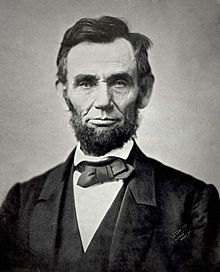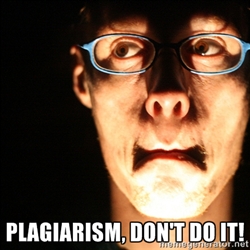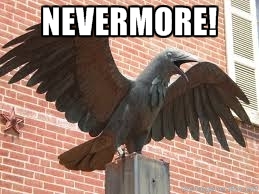You’ve heard your instructor rant, rave, and threaten about avoiding plagiarism since the beginning of the school year, but now that the first major paper is almost due, you are starting to panic.
Can you plagiarize on accident? What counts as plagiarism? What are you going to do?
WHAT ARE YOU GOING TO DO?
All right. Knock off your caps lock already. Keep calm and read on. I’ve got answers for you. Let me teach you how to avoid plagiarism in your writing.
What Is Plagiarism Exactly?
No one wants to speak up in class and ask the seemingly obvious question: What is plagiarism? How can I know how to avoid plagiarism if I don’t know what it is?
Read on, and I’ll give you what you need to know.
First of all, Merriam-Webster describes plagiarism as the “the act of using another person’s words or ideas without giving credit to that person,” but you probably already looked that up, and it doesn’t exactly lay it out for you. I mean, your research essay or book report is going to be full of another person’s ideas, right?
Plagiarism can be any of the following:
- Using someone’s exact quote without quotation marks
- Copying someone else’s work word for word from start to finish
- Not properly attributing the quote to the author using your appropriate style guide
- “Paraphrasing” too closely to the original text
So, that’s all fine and dandy, but what’s the big deal about avoiding plagiarism? Is there really such a thing as an original idea anyway?
Why Plagiarism Can Be Deadly
Plagiarism can quite literally kill your grades, even if you have committed an act of plagiarism on accident. But, what’s the problem? Why are instructors so worked up about plagiarism?
If you think about someone’s writing or idea as intellectual property, then re-using that idea or writing without attribution is a lot like stealing. Stealing is illegal, and plagiarism has similar repercussions.
Don’t think you can pull a fast one on your instructor by plagiarizing on purpose, either. There are plenty of free plagiarism checkers online now, so it is not difficult for a teacher or professor to bust you.
Plagiarism is not the easy way out of writing an essay.
Though you might not think that the information you included without attribution in your paper about the history of silkworms really constitutes stealing, think again. Your instructors want you to use your own work so you can get a grade that is truly representative of the work you did for the class.
Now that I’ve told you all the horror stories associated with plagiarism, let’s turn the flashlights off, get away from the campfire, and go back to the drawing board.
How to Avoid Plagiarism – 3 Easy Methods
Let’s talk about how to avoid plagiarism.
To avoid plagiarizing, you have several options: paraphrasing, using quotation marks, and citing your sources.
For formal papers, a combination of those methods is often necessary.
Method 1. Paraphrasing
When writing a research paper of any sort, you will likely end up paraphrasing a lot. Once you have collected all your sources, you will use the information you learned to draw conclusions about your topic.
This method is super useful because, as we all know, you can’t just quote sources back to back to back to back. That would get you the same bad grade that plagiarizing would. Can’t have that. No sir.
Instead, you can paraphrase. Paraphrasing is a lot like summarizing except that, instead of condensing the information in the source, you just reword the information.
Here is a quote from the Gettysburg Address to use as an example:
“Four score and seven years ago our fathers brought forth on this continent, a new nation, conceived in Liberty, and dedicated to the proposition that all men are created equal.”
If I wanted to paraphrase that, it might look something like this:
The founders of this nation were devoted to freedom and equality when they formed the United States 47 years before the Gettysburg Address.
Essentially, the two sentences mean the same thing, even though Abe Lincoln might have been more eloquent than I am. Remember that, depending on the style guide you are using, you still have to cite the source of your paraphrase in the text and/or on your essay’s reference page.
But, the point here is don’t plagiarize.
If you were to just say that our fathers brought forth on this continent, a new nation, conceived in Liberty without any quotation marks or attribution or anything, you’ve just plagiarized, friend.

Also remember that you can’t just paraphrase for your whole essay either (aww, shucks). You have to intertwine your ideas with the ideas presented in your source material.
(Read 10 Examples of Paraphrasing for a Smarter, Better Essay)
Method 2. Using Quotation Marks
The second way to learn how to avoid plagiarism is to use quotation marks. This method is relatively straightforward, but you need know to where you need quotation marks and when you can leave them out.
Say you are going to use the opening line of Edgar Allen Poe’s poem, “The Raven.” How much of the sentence should you quote? If you are just referencing a few words, do you need to quote them? Let’s look at some examples.
For this example, we will use the following sentence:
“Once upon a midnight dreary, while I pondered weak and weary…”
If you wanted to use textual evidence to prove that the speaker in the poem was tired when he encountered the raven, you might say something like this:
It is important to note that the speaker is “weak and weary,” which may have contributed to his or her irritation at the raven.
Because the words “weak” and “weary” represent an important thought in the text, the phrase needs to be quoted directly.
However, if you were explaining why that quote is important, you wouldn’t write something like this:
Though the raven sat “upon a” bust peacefully, the speaker quickly becomes irritated with the raven’s presence, possibly due to his or her lack of sleep.
Here, because “upon a” doesn’t really convey an important idea and is a commonly used phrase, you don’t need to quote it just because the words happen to appear in the poem you are writing about.
Look! You’re one step closer to learning how to avoid plagiarism! It will soon be a thing of the past for you.
Method 3. Citing Your Sources
Hopefully, your instructor told you which citation manual you should be using, usually, MLA, APA, or Chicago. Using one of those style guides, you need to make sure that all the sources you used to construct your argument or research paper are appropriately included. You will likely have to include in-text as well as full citations.
(Need more help with MLA? Read How to Write MLA Citations Without Going Crazy)
If you don’t include your citations, and you used a source that is not listed, even if you were paraphrasing, that is still plagiarism. If, after paraphrasing, quoting, and citing, you’re still concerned about plagiarism in your work, check your paper with this handy plagiarism checker!
Once your paper is drafted, head over to Kibin for some essay editing help, so we can make sure your citations are correct, your quotations are seamless, and your paraphrases are grammatically sound.
Good luck!


